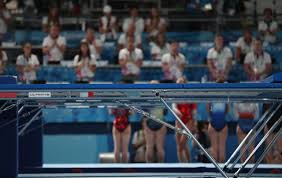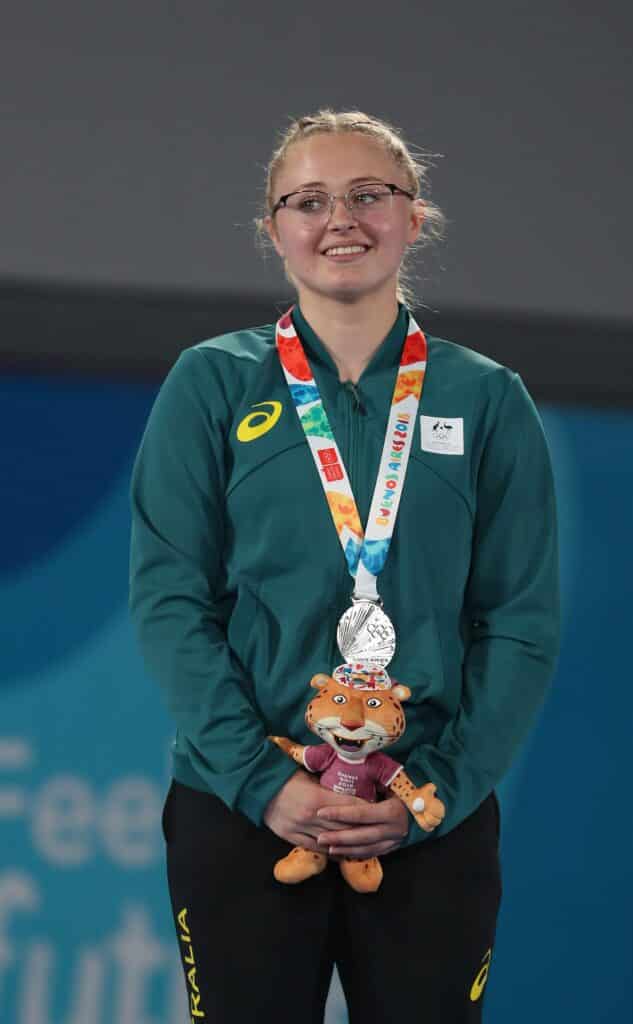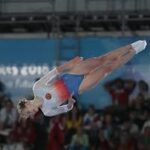Trampolining has followed a bumpy road on its quest for inclusion in the Olympic Games. From skepticism and roadblocks to breakthrough performances, trampoline athletes have fought for decades to prove their sport deserves a spot among the highest levels of gymnastic achievement.
Their persistence ultimately paid off now that Trampoline is in the Olympics.

Table of Contents
- Early Olympic Exhibition Performances
- The Case for Olympic Inclusion
- Resistance From Gymnastics Federations
- Breakthrough as an Olympic Exhibition Sport
- When did Trampolining Become an Olympic Sport?
- Trampoline’s Rising Olympic Popularity
- Trampolining for the Masses
- References
Early Olympic Exhibition Performances
Trampolinists first appeared at Olympic Games in the 1960s-1970s during opening ceremonies or in exhibition shows outside the competition:
- At the 1964 Tokyo Olympics, a trampoline demonstration captivated crowds as proof of concept (1).
- In 1972 at Munich and 1976 in Montreal, non-competing trampoline routines were included in opening ceremonies as entertainment (2).
While not in true competition, these showcases gave the Olympics an early taste of trampolining’s athletic appeal.
The Case for Olympic Inclusion
Through the 1970s, trampoline leaders increasingly lobbied for full medal status in the Olympics. Key arguments included:
- Trampolining was now an advanced sport requiring immense skill and fitness (3).
- It was governed by national and international federations with formal rules and rankings.
- Women were equally involved, making it a great gender-equal addition.
- It would draw interest and expand the Olympics’ gymnastic program.
But the effort faced serious hurdles.
Resistance From Gymnastics Federations
In the 1970s, trampolining’s bid for independent Olympic status was repeatedly rejected. The International Gymnastics Federation (FIG) controlled Olympic gymnastic spots and saw trampolining as a sideshow rather than a real sport (4).
Some in the gymnastics community looked down on trampoline athletes as less disciplined or legitimate than artistic gymnasts. They worried trampolining’s inclusion would dilute resources for more established gymnastic events.
Breakthrough as an Olympic Exhibition Sport
Trampolinists finally achieved a milestone when trampolining was approved as an Olympic exhibition sport at the 1996 Atlanta Games. For the first time, medal competitors demonstrated their skills at the highest international stage.
While not yet granted full status, this exhibition signaled trampolining could stand alongside elite gymnastic disciplines. The impressive routines on display strengthened the case for trampolining’s Olympic future (5).
When did Trampolining Become an Olympic Sport?
A major breakthrough came in 1998 when gymnastics’ world governing body FIG finally formed a dedicated Trampoline Technical Committee, after years of trampoline leaders’ lobbying.
This committee gained authority to guide trampolining’s rules, rankings and development. Their oversight helped demonstrate that trampolining was mature enough for full entry into the Olympic Games (6).

Trampoline’s Olympic Debut in Sydney
At the 2000 Sydney Olympics, trampolining made its long-awaited debut as an officially approved medal event. After decades of marginalization, trampoline athletes finally had the chance to compete for Olympic gold on the world’s biggest stage.
Legends of the sport like Alexander Moskalenko of Russia and Irina Karavaeva and Natalia Pavlova of Ukraine won the first Olympic trampoline titles, cementing themselves in history (7). Their triumphant performances marked trampolining’s arrival as an equal among Olympic gymnastic sports.
Trampoline’s Rising Olympic Popularity
In the 5 Olympic appearances since its debut, trampoline has cemented itself as a beloved highlight full of high-flying excitement:
- Iconic champion Irina Karavaeva demonstrated true Olympic greatness by winning 3 straight golds from 2000-2008.
- Canada’s Rosie MacLennan captured trampoline gold at both the 2012 and 2016 Games.
- In Tokyo 2020, China’s Zhu Xueying stunned as a first-time gold medalist against veteran competitors.
Trampoline routinely draws strong TV ratings and crowd enthusiasm thanks to its thrilling athletic display (8).

Trampolining for the Masses
Trampoline’s Olympic spotlight has fueled its popularity as a recreational activity. Backyard and gym trampolines have become commonplace, with kids dreaming of mimicking their Olympic heroes.
Trampolining is among the most participated school sports worldwide, providing an accessible introduction to inverted skills. And trampoline parks have become favorite hangout spots thanks to that enduring human desire to bounce.
While still niche compared to artistic gymnastics, competitive trampolining has grown significantly since its cautious Olympic start. Its exciting appeal looks destined to entertain Olympic crowds for decades to come.
References
- https://stillmed.olympics.com/media/Documents/Olympic-Org/Factsheets/The-Olympic-Programme/Olympic-Programme-Factsheet.pdf
- https://journals.uair.arizona.edu/index.php/azine/article/view/18267/18067
- https://usagym.org/pages/gymnastics101/history/trampolinehist.pdf
- http://www.ausport.gov.au/sportscoachmag/gymnastics/demystifying_trampolining
- https://library.la84.org/OlympicInformationCenter/OlympicReview/1996/orexxvi30/OREXXVI30j.pdf
- https://www.olympic.org/news/ioc-approves-olympic-programme-for-sydney-2000
- https://www.wtvf.com/article/sports/olympics/trampoline/trampolining-pioneers-recall-battling-prejudice-en-route-to-olympic-debut/507-8816c4bf-9725-4b1b-add2-b37a3d6a52b4
- https://theconversation.com/sport-on-screen-why-trampolining-is-perfect-for-tv-84490
- The 12 Types of Trampoline (explained)
 Trampolines, a staple of joy and fitness, cater to all ages, inspiring kids and adults alike to leap out of their indoor routines into a… Read more: The 12 Types of Trampoline (explained)
Trampolines, a staple of joy and fitness, cater to all ages, inspiring kids and adults alike to leap out of their indoor routines into a… Read more: The 12 Types of Trampoline (explained) - Trampoline In The Olympics (History)
 Trampolining has followed a bumpy road on its quest for inclusion in the Olympic Games. From skepticism and roadblocks to breakthrough performances, trampoline athletes have… Read more: Trampoline In The Olympics (History)
Trampolining has followed a bumpy road on its quest for inclusion in the Olympic Games. From skepticism and roadblocks to breakthrough performances, trampoline athletes have… Read more: Trampoline In The Olympics (History) - The Top 9 Trampoline Health Benefits
 Trampolining, once just a popular backyard activity, is now a serious fitness trend. It’s a fun way to get your body moving, burn calories, and… Read more: The Top 9 Trampoline Health Benefits
Trampolining, once just a popular backyard activity, is now a serious fitness trend. It’s a fun way to get your body moving, burn calories, and… Read more: The Top 9 Trampoline Health Benefits - Are In Ground Trampolines Safer?
 Backyard trampolines are a fantastic way to keep children of all ages happy, healthy and busy. Choosing the safest type of trampoline for your family… Read more: Are In Ground Trampolines Safer?
Backyard trampolines are a fantastic way to keep children of all ages happy, healthy and busy. Choosing the safest type of trampoline for your family… Read more: Are In Ground Trampolines Safer? - How to Winterize A Trampoline (guide)
 Winter is not just a season of snow and cozy firesides; it’s also a time when our beloved outdoor equipment needs extra care to survive… Read more: How to Winterize A Trampoline (guide)
Winter is not just a season of snow and cozy firesides; it’s also a time when our beloved outdoor equipment needs extra care to survive… Read more: How to Winterize A Trampoline (guide) - How to Choose a Trampoline (guide)
 In this guide, we’ll bounce through the essentials of how to choose a trampoline, from size and shape to durability and bounce quality, ensuring you… Read more: How to Choose a Trampoline (guide)
In this guide, we’ll bounce through the essentials of how to choose a trampoline, from size and shape to durability and bounce quality, ensuring you… Read more: How to Choose a Trampoline (guide)
